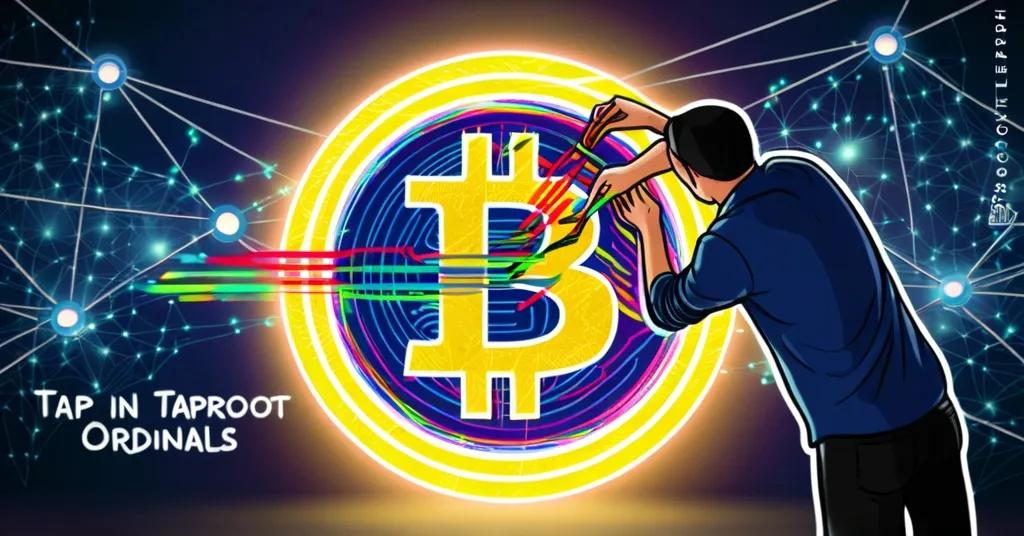Bitcoin Ordinals: Revolutionizing Digital Ownership with Taproot Upgrade

Bitcoin Ordinals: A New Era of Digital Ownership on the Blockchain
Bitcoin Ordinals have ushered in a new era of digital ownership, allowing users to inscribe art, text, and other data directly onto the Bitcoin blockchain. Enabled by the 2021 Taproot upgrade, this revolutionary feature has sparked both excitement and debate within the crypto community.
- Digital assets inscribed onto Bitcoin’s blockchain
- Enabled by the 2021 Taproot upgrade
- Introduces new use cases but raises concerns about network congestion and fees
Bitcoin Ordinals represent a groundbreaking shift in how we perceive digital assets. These assets are inscribed onto individual satoshis (sats), the smallest unit of Bitcoin. Imagine owning a piece of digital art that’s as permanent as the Bitcoin blockchain itself. This isn’t just a pipe dream—it’s what Bitcoin Ordinals make possible. They leverage the Ordinal Theory, which assigns a unique number to each satoshi, and use inscriptions to attach digital content like art or text directly onto the blockchain. This method offers a more secure and immutable form of digital ownership compared to traditional NFTs, which often rely on off-chain storage and smart contracts.
The 2021 Taproot upgrade played a pivotal role in making Bitcoin Ordinals a reality. By expanding Bitcoin’s transaction data capacity, Taproot not only improved privacy and efficiency but also opened the door to embedding data onto the blockchain. For those eager to mint their own Ordinals, the process involves using a Taproot-compatible wallet, such as Sparrow Wallet or Xverse, or opting for inscription services like OrdinalsBot or Gamma. Running your own Ordinals node offers the most control, but these services provide an accessible entry point for newcomers.
Trading Ordinals is still in its early stages, with transactions primarily occurring peer-to-peer or through emerging marketplaces like Magic Eden and Gamma. As the market for Ordinals grows, we’re likely to see new platforms and tools emerge to facilitate their exchange and showcase their unique value. Notably, some Ordinal-based art sales have even surpassed those of Ethereum NFTs, indicating a growing market interest and potential economic impact.
However, the rise of Bitcoin Ordinals isn’t without its challenges. The increased demand for block space has led to higher transaction fees and network congestion, sparking debates within the Bitcoin community about the trade-offs between innovation and practicality. Critics, including prominent figures like Adam Back and Luke Dashjr, argue that Ordinals could compromise Bitcoin’s primary function as a currency. They worry about the potential for blockchain spam and space inefficiency. On the other hand, proponents like Austin Alexander from LayerTwo Labs see Ordinals as beneficial for Bitcoin’s long-term security by incentivizing miners through transaction fees. They argue that Bitcoin needs to demonstrate utility to justify these costs.
Despite these challenges, the future of Bitcoin Ordinals looks promising. Ongoing developments aim to improve usability and scalability, with potential solutions like the Lightning Network on the horizon to address the issue of high fees. The Nakamoto release of Stacks and the upcoming mainnet of Merlin Chain are examples of projects that could enhance Bitcoin’s scalability and functionality, potentially benefiting Ordinals. As wallet support improves and dedicated marketplaces emerge, the adoption and usability of Bitcoin Ordinals are likely to soar, opening up new possibilities for creators and collectors alike.
Bitcoin Ordinals align with Satoshi Nakamoto’s vision for Bitcoin’s capabilities, as they push the boundaries of what’s possible on the blockchain. While they may not serve every niche that altcoins and other blockchains do, they add a unique layer of utility to Bitcoin, demonstrating its potential beyond just being a store of value. As we navigate this new frontier of digital assets, it’s clear that Bitcoin Ordinals represent a pivotal moment in the evolution of blockchain technology. They challenge us to rethink what’s possible on the Bitcoin network and invite us to explore the potential of a decentralized, immutable canvas for digital expression.
Key Takeaways and Questions
What are Bitcoin Ordinals?
Bitcoin Ordinals are digital assets inscribed onto individual satoshis, allowing the storage of art, text, and other data directly on the Bitcoin blockchain.
How do Bitcoin Ordinals work?
They utilize the Ordinal Theory to track each satoshi and inscriptions to embed data into sats, made possible by the Taproot upgrade.
How can one mint Bitcoin Ordinals?
The process involves using a Taproot-compatible wallet, potentially running an Ordinals node, or using inscription services, and paying associated transaction fees.
How are Bitcoin Ordinals bought, sold, and traded?
Currently, they are traded peer-to-peer or through emerging marketplaces like Magic Eden and Gamma.
What impact have Bitcoin Ordinals had on Bitcoin?
They have introduced new use cases, increased transaction fees, and sparked debates about network congestion.
What are the challenges and criticisms of Bitcoin Ordinals?
Challenges include network congestion, high fees, and a lack of smart contract support. Critics argue that Ordinals could compromise Bitcoin’s primary function as a currency.
What does the future hold for Bitcoin Ordinals?
Future developments may include better wallet support, dedicated marketplaces, and scalability solutions like the Lightning Network.
Will the increased transaction fees and network congestion caused by Ordinals lead to a significant backlash from the Bitcoin community?
It’s possible, as some community members prioritize Bitcoin’s efficiency over new use cases, but others see Ordinals as a way to enhance Bitcoin’s long-term viability.
Can the Bitcoin network handle the additional load that Ordinals bring without compromising its primary function as a currency?
With ongoing developments like the Lightning Network, the network may be able to adapt, but it’s a delicate balance that requires careful consideration.
How will the development of dedicated marketplaces and improved wallet support affect the adoption and usability of Bitcoin Ordinals?
These improvements are likely to significantly boost adoption by making Ordinals more accessible and user-friendly for both creators and collectors.
Could the integration of scalability solutions like the Lightning Network adequately address the high fees associated with Ordinals?
The Lightning Network has the potential to reduce fees, but its effectiveness for Ordinals will depend on how well it integrates with the existing infrastructure.



